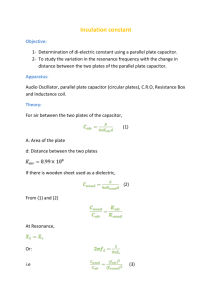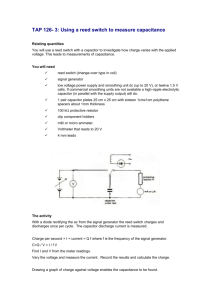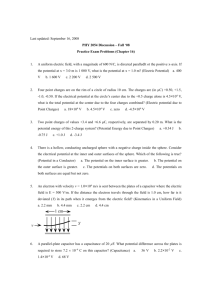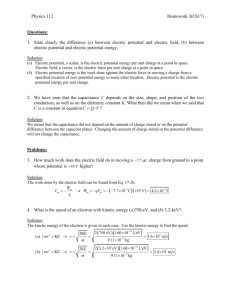Ch26-1
advertisement
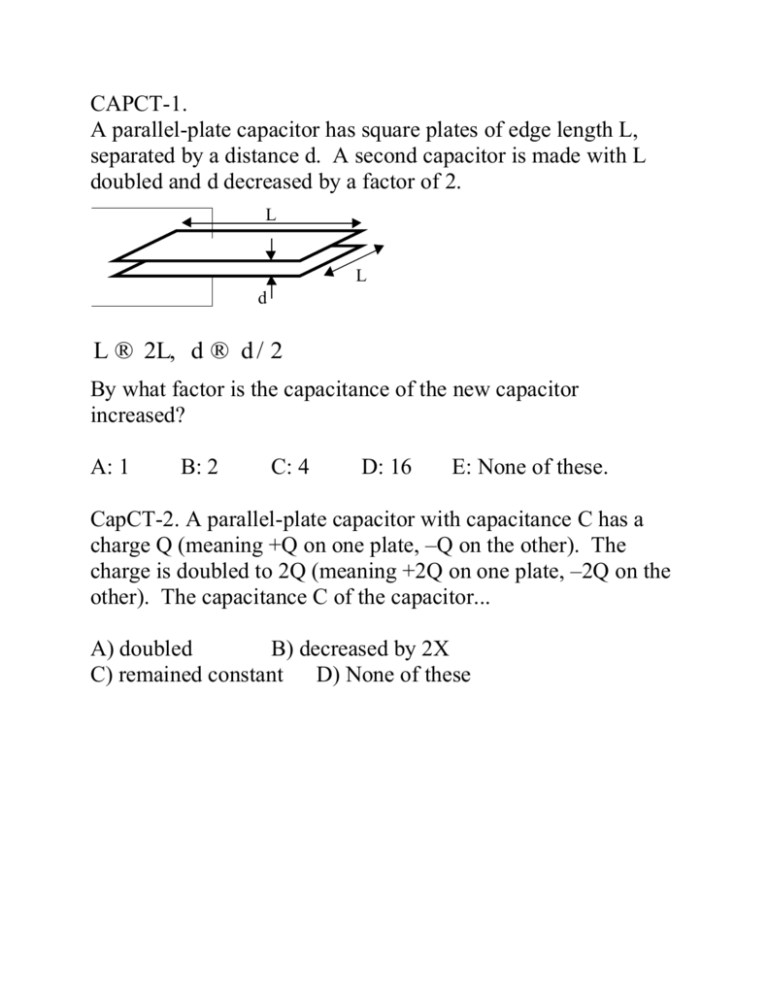
CAPCT-1. A parallel-plate capacitor has square plates of edge length L, separated by a distance d. A second capacitor is made with L doubled and d decreased by a factor of 2. L L d L ® 2L, d ® d / 2 By what factor is the capacitance of the new capacitor increased? A: 1 B: 2 C: 4 D: 16 E: None of these. CapCT-2. A parallel-plate capacitor with capacitance C has a charge Q (meaning +Q on one plate, –Q on the other). The charge is doubled to 2Q (meaning +2Q on one plate, –2Q on the other). The capacitance C of the capacitor... A) doubled B) decreased by 2X C) remained constant D) None of these CAPCT-3. A parallel-plate capacitor is charged up (+Q on one plate, –Q on the other). The plates are isolated so the charge Q cannot change. The plates are then pulled apart so that the plate separation d increases. The total electrostatic energy stored in the capacitor A: increases +++++++++++++++++++++ - - - - - - - - - - - - - - - - - - - - B: decreases C: remains constant. (Hint: Did the person pulling the plates apart do positive work, negative work or no work?) As the plates were pulled apart, the energy density (energy per volume) = u = (1/2)oE2 .... A) increased B) decreased C) stayed the same. CAPCT-4. A parallel plate capacitor is attached to a battery which maintains a constant voltage difference V between the capacitor plates. While the battery is attached, the plates are pulled apart so their separation increases. The electrostatic energy stored in the capacitor A: increases V +++++++++++++++++++++ - - - - - - - - - - - - - - - - - - - - B: decreases C: stays constant. CAPCT-5. A positive charge +Q and a negative charge –Q are held a distance R apart and are then released. The two particles accelerate toward each other as a result of their coulomb attraction. As the particles approach each other, the energy contained in the electric field surrounding the two charges.. + A: increases B: decreases C: stays the same. CAPCT-6. The inner surfaces of the two plates of a capacitor have uniform charge per area 1 and 2. Consider the gaussian surface S. 1 S 2 From Gauss's Law, you can conclude that A) 1 = 2 always. B) 1 = – 2 always. C) You cannot conclude anything from Gauss's Law: 1 and 2 can be anything CAPCT-7. Consider a metal in electrostatic equilibrium. The voltage difference between two different points in the metal .. A) is zero always. B) could be positive, negative, or zero, depending on the charges on the surface. V CAPCT-8. Consider any two capacitors C1 and C2 hooked together in parallel. They may or may not be hooked to a battery. C1 C2 V C1 C2 What thing is definitely the same for the two capacitors? A) the capacitance (C1 = C2) B) the voltage (V1 = V2) ("V" means V, of course) C) the charge (Q1 = Q2) (charge "Q" means +Q on 1 plate , –Q on the other) D) All of these E) None of these CAPCT-9. Consider any two capacitors C1 and C2 hooked together in series. They may or may not be hooked to a battery. C1 C1 V C2 C2 What thing is definitely the same for the two capacitors? A) the capacitance (C1 = C2) B) the voltage (V1 = V2) ("V" means V, of course) C) the charge (Q1 = Q2) (charge "Q" means +Q on 1 plate , –Q on the other) D) All of these E) None of these How do the voltage differences across the two capacitors (V1 and V2) relate to the voltage V on the battery? A) V = V1 = V2 B) V = V1+V2 C) V = V1–V2 D) V = V2 – V1 E) V is not related in any definite way to V1 and V2 CAPCT-10. Two capacitors C1 and C2 are hooked in series. The equivalent series capacitance of the two capacitors is … A: Always less than C1 or C2 B: Always greater than C1+C2 C: Always greater than C1 or C2 but always less than C1+C2 D: None of these. = C1 C2 Cseries CAPCT-11. What is the effective total capacitance of this arrangement of capacitors? A) 0.5 F B) 2 F C) 4 F D) 8 F E) Other C2=2 F C1=4 F C3=2 F CAPCT-12. A parallel-plate capacitor with a dielectric between the plates is charged so that +Q resides on one plate, –Q on the other. With the plates isolated and the charge Q constant, the dielectric is pulled out from between the plates. The energy stored in the capacitor ... A: increased B: decreased C: stayed the same. +Q -Q +Q -Q Hint: Was work done when the dielectric was removed? CAPCT-13. Same question, except now the capacitor is hooked to a battery which maintains a constant voltage between the plates as the dielectric is removed. With the voltage fixed, as the slab was removed, the charge Q on the capacitor .. A: increased B: decreased C: stayed the same. +Q V -Q The energy stored in the capacitor ... A: increased B: decreased C: stayed the same. CAPCT-14. Consider a capacitor made of two isolated parallel metal plates separated by a distance d. The top plate is positively charged with total charge +Q; the bottom plate is negatively charged with total charge –Q. A slab of metal of thickness t < d is inserted between the plates, not connected to either one. Upon insertion of the metal slab, the voltage difference between the top and bottom plates. [Hint: V = E d ] A: increases B: decreases C: remains constant. Another hint: The charge density, before and after, looks like: After insertion of the third plate, the ratio Q/V where Q is the charge on the top plate and V is the voltage difference between top and bottom plates.. A: increases B: decreases C: remains constant.

